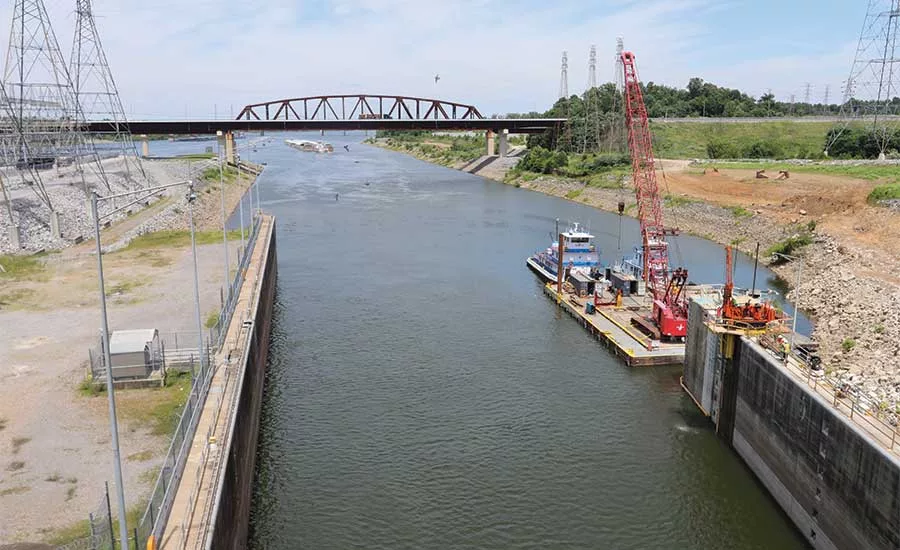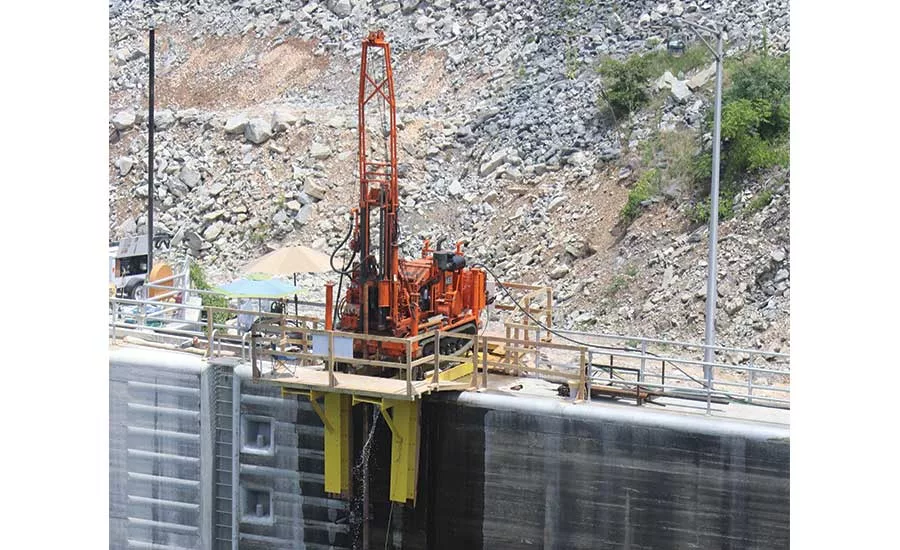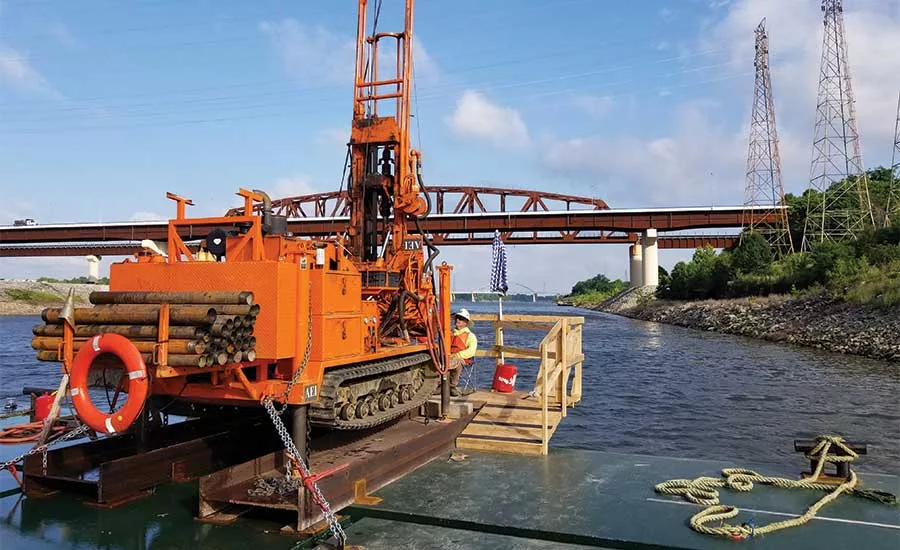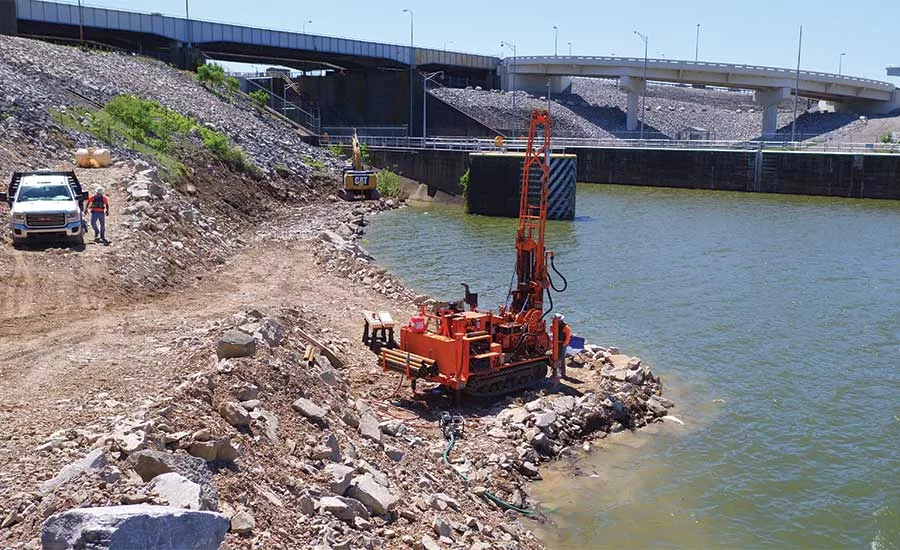Dam Project Features Drilling Challenges from Land, Water, Air

An aerial platform supports a drill rig on a narrow guide wall for the Kentucky Dam in Livingston County, Ky. American Engineers Inc. was the subcontractor for geotech work in advance of a major expansion of the dam’s lock system.
Source: American Engineers Inc. photos


The water-based drilling was done from a Flexifloat system. Two I-beams were mounted on the Flexifloat with a slight overhang. The rig was then secured to the I-beams.
Source: American Engineers Inc. photos

Bottlenecks on transportation can limit the growth and productivity of an entire region. The lock system at the Kentucky Dam has such a bottleneck.
The navigational lock system for the dam, built during the New Deal civil construction boom of the later 1930s and early ’40s, accommodates 600-foot barges. Seventy years ago, that served the region’s transportation needs just fine. In 2018, though, it’s just not enough.
Drillers are helping the U.S. Army Corps of Engineers open up that bottleneck to barges twice that size.
“The primary scope,” says Clint Ervin, project engineer and geotechnical drilling manager, “was to provide the Corps of Engineers subsurface data of the existing geology within the site for placement of the downstream coffer dam and some additional data for the design of the footings that they’re going to have to build for this new lock system that’s going to be adjacent to the existing one.”
Ervin, of American Engineers Inc. (AEI), had an active role in the geotechnical aspects of the project in Livingston County, Ky., where the Tennessee River dumps into Kentucky Lake, the reservoir created by the Kentucky Dam. AEI, founded in 1983, serves civil construction markets with engineering and design services from three locations in Kentucky and one in Georgia.
“We’ve done a lot of work in the federal market recently, and are looking to expand those services. Honestly, this project is what we feel is a very positive step in that direction,” says Dennis Mitchell, AEI director of geotechnical services. He was the senior engineer on the project.
AEI rose to the challenge, which involved drilling from land, sea and an innovative platform perched atop a guide wall for the lock. The project involved 19 borings: eight on land, eight from a floating barge and three from the aerial platform. The purpose of each boring was to quantify overburden, classify the rock of those specific points and document formations below ground to make sure, when the lock expansion is finally built, there are no seepage issues.
Between the project design and logistics, and the formation, it wasn’t an easy job.
From the Air
It’s not every day that you get to drill from atop a narrow wall over water. The three bores from the aerial platform took planning and engineering know-how.
“We worked together with Johnson Brothers, which is who we were subbed to, to design this platform which is essentially a saddle that goes over the guide wall,” Ervin says. “Their structural engineers designed it. They submitted the plans to us and we went over the calculations to make sure they had the load rating for the drill — dead weight, the load rating for the drill pull-down forces that it can apply while it’s drilling. We dotted our Is, crossed our Ts and even dotted the lowercase Js on this one.”
The plans, of course, also got reviewed by USACE. Once everyone signed off, it was a matter of execution. Once the saddle was placed and anchored, the rig itself was lowered onto the platform from a barge-based crane.
“From there, our next challenge was trying to get our steel started,” Ervin says, “because we had 30 feet of pre-boring from our working platform down to the top of the water surface, then an additional 15 feet or so of water down to the channel bottom. Then you have the uncertainty of what the bottom’s like, whether it’s smooth or whether there are boulders.”
They attached guide anchor in a path down to the water’s surface to run steel through and keep it from flexing. The folks at AEI likened the drilling process on those three holes to grabbing a pencil by the eraser, then trying to write with it.
Between holes, or if they hit anything they couldn’t drill through, the drill would get taken down and the saddle freed up, moved and re-anchored, before the crane would restore the rig to its perch to begin drilling again. The process was time-consuming, but went according to plan.
From the Water
Coring within the confines of an operational lock presented its own challenges, as Ervin explains.
“Our driller, Adam Thompson, would have to watch the water’s edge to keep an eye on the rocks, how the water would go up and down on the rocks, to know that the water is either rising or lowering so he could adjust his pressures on the drill so we didn’t burn up a bit or get off on our depth.”
That was once the Flexifloat system was assembled, the rig mounted on overhanging I-beams, and the whole contraption moved onto specific GPS coordinates with the help of on-shore surveyors. Even with that level of preparation though, the fluctuating water levels made coring an inexact science.
“We were doing 10-foot cores, and there were some instances where we would have 10.3 feet because the water elevation changed throughout that run and we would gain footage,” Ervin says. “We had to constantly review logs and adjust the coring with the elevation changes of the water.”
Ervin also emphasizes the “operational” aspect of the lock.
“We had barge traffic coming in all the time. We had to have a 24-hour helper boat with us at all times to keep the barges from running into our Flexifloat system and breaking our steel off into the water.”
Brad High, the project geologist, says they also had to take care with grouting. Each of the bores was grouted closed after drilling and pressure testing.
“For the water boring, per the specs on the project, we couldn’t put in more than the planned, calculated volume of the grout,” he says. “We didn’t want to create any grout plumes in the waterway.”
From the Shore
Oddly enough, AEI says the land-based drilling for this project offered the most challenges. Ervin says sometimes water fluctuations near the shore inundated their drilling targets.
”When we got there, some of our land-based ended up being water-based. … We’re also working in the vicinity of an operating hydroelectric dam, which was just right on the other side of this lock system. We did the majority of this work during the spring, so we had water fluctuations of 15 feet sometimes — and that would be 15 feet over a weekend. We would have to look at the boring layouts and look at the elevations — the existing elevations and look at the proposed water elevations over the weekend — and make adjustments on the fly.”
They even had one instance where they set up on dry land to drill in the morning and the site had standing water by lunch.
Mitchell also says the land-based drilling was just plain tougher.
“Really, what we found throughout the course of the project was working on the barge was actually easier than working on the land because of the boulders and obstructions that were one, at the surface, but they also seemed to be more prevalent in terms of thickness — the overburden tended to be more difficult to get through on the land.”
One More Bore
Each part of this project has its challenges — whether on land, water or suspended 30 feet in the air — that AEI and Johnson Brothers rose to meet for their client. But there’s still one more challenge, Ervin says.
“We have one boring left that’s within the lock channel very close to the lock gate. This one, we were not able to access it from the aerial platform. The only option that we have for that one was to do it from a floating platform, the Flexifloat system. But that’s going to require a temporary shutdown of the lock, which I think is something they don’t like to keep in their vocabulary.”
The shutdown required 45 days of notice. Then, AEI will return to do the entire 130-foot coring run in one continuous shift. That work is expected to happen in early summer this year.
The whole project has raised AEI’s profile, Mitchell says.
“For our growth, it really expanded our drilling capabilities and our ability to show our expertise to the Corps of Engineers on this project. … That as much as anything was what enticed us to this project. We basically were able to perform at a high level and met or exceeded the contractor and the district’s expectations. Above and beyond just making a profit on the project, that was a very important output for us.”
Looking for a reprint of this article?
From high-res PDFs to custom plaques, order your copy today!





